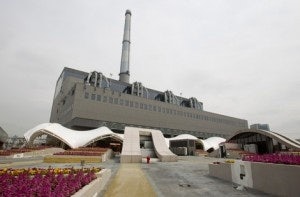Power Station of Art First State-Owned Mainland Chinese Contemporary Art Museum#

Launching this week to coincide with the National Day holiday, two sprawling new state-owned museums are expected to boost Shanghai's chances of taking on Beijing as a cultural -- rather than just a financial -- hub. Located inside the landmark red building that functioned as the China Pavilion at the 2010 Shanghai World Expo, the
China Art Palace#
(announced last fall) comprises an eye-popping 64,000 square meters of exhibition space split up into 27 halls. According to the Art Newspaper, the museum will focus mainly on classic works that highlight the development of modern art in China, collected from the holdings of government-owned museums and art companies:
[The China Art Palace's] opening exhibition has five parts, which do not yet have official English translations. The 600 pieces in “Shanghai Brightness” trace the origins of China’s modern art. “Congratulations from the World” features 100 pieces from seven countries. “Splendid China” features 250 works of 21st-century Chinese art, while “Historical Shanghai Contexts” includes 64 pieces.
The “Masters’ Hall” features 460 works from artists including Lin Fengmian, Guan Liang and Wu Guanzhong. The multimedia recreation of the classic scroll “Ascending the River at Qingming Festival” that was the China Pavilion’s star attraction during the Expo will be on permanent display. “Miller, Courbet and Naturalism in France”, featuring loans from the Musée d’Orsay, Paris, is due to open in November.

Across the Huangpu River, the somewhat awkwardly -- yet aptly -- named
Power Station of Art#
is the first state-owned museum in mainland China that focuses on contemporary art. A former power station (hence the name), the museum includes more than 9,000 square meters of exhibition space spread throughout a dozen halls across 41,200 square meters. For its first effort, the building will host the 2012 Shanghai Biennale, running from October 2, 2012-March 31, 2013, after which the museum plans to launch an Andy Warhol retrospective.
Shanghai officials are optimistic that the new museums will help in their city's bid to leverage its cultural advantages and display a treasure trove of rarely seen artwork. “As the home of Chinese modern art,” Zong Min, deputy head of the Publicity Department of the CPC Shanghai Municipal Committee recently explained, “Shanghai has collected millions of works of art over the last two centuries. There are more than 30,000 boutique works of art kept in the city’s public museums and universities. [However,] because the Museum of Contemporary Art Shanghai and Shanghai Art Museum have a total of only 6,800 square meters of display space, many [artworks] have ended up locked up at a warehouse, out of…public view.”
With free admission, Hu expects the museums will receive 3 million visitors in their first year and “will continue to buy or accept donated works of boutique art from both home and abroad.”
Shanghai’s well-capitalized initiative to foster a more creative environment in the city has invigorated the city's cultural ambitions. Over the last few years, new creative/lifestyle venues like 1933 (a restored Jazz Age abattoir), the Shanghai Songjiang Creative Studio, and the Rockbund Art Museum have opened their doors, and though red tape and fly-by-night private gallery owners continue to plague the industry, by 2015, Shanghai plans to open upwards of 16 more large-scale museums and galleries.
